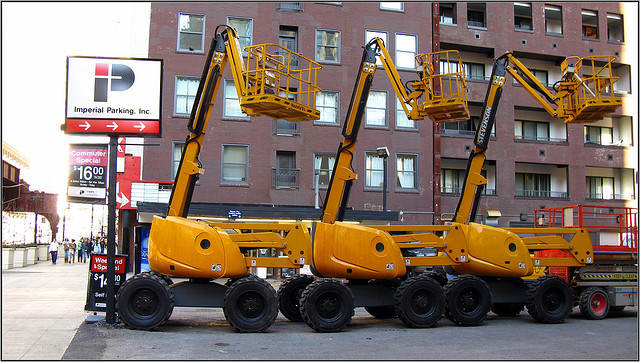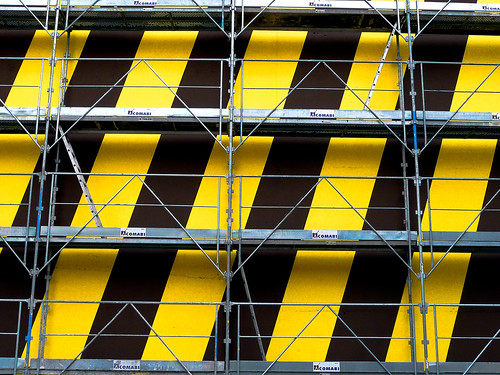When it comes to a big job, professionals know they need commercial painting tools to get the job done right. Professional or commercial painters could be faced with a tall order. You could be hired to paint extra high ceilings or large surfaces of wall space. Having the proper commercial painting tools doesn’t point to a paint roller and an extension rod. Instead, it’s time to break out the heavy equipment like scaffolding, cranes, and scissor lifts. This kind of equipment can help get the job completed on time, under budget, and up to a customer’s expectations.
Aerial Work Platforms
Aerial work platforms are generally a work-space that can be mechanically lifted or hoisted into tall spaces. Unless a painter is in need of this type of equipment on a regular basis, it may not be cost effective to purchase an expensive crane or boom truck. Instead, you should establish a good working relationship with a local heavy equipment company and work out a contractor deal for rental fees. The type of equipment you need really depends on the needs of each particular job.
Manlifts: A manlift looks like something you might have seen coming out of the cargo bay of a space shuttle. In fact, the engineering behind both mechanical arms is similar. This commercial painting tool is used on a construction site for more than just painting. The arm in a mechanical manlift allows movement up, down, and side-to-side. There are tow-able models that can be hauled on a hitch. A straight-arm lift can’t give you as much freedom in movement, but can give you great height. It helps workers lift materials from the ground to sometimes up to four stories high.
Scissor Lifts: Scissor lifts are called as such because of the accordion support system that raises and lowers the cage up and down. There is no arm in this machine. You simply use this commercial painting tool to lift straight up and down. There are controls in the cage so the operator can move the lift throughout the space with ease. It’s a great piece of equipment to have on hand when painting a super size room with tall ceilings.
Scaffolding and Ladders
While some jobs require the big equipment, others just don’t warrant the expense and hassle of hauling large commercial painting tools on site. Scaffolding and ladders are a little lower tech approach, but they certainly help you get the job done. Just make sure you have plenty of people on your team ready to help you get them in place. Putting together and setting up scaffolding is not a one or two person job. The more hands there are to help, the quicker the work.
Scaffolding: Scaffolding has been around for centuries. In fact, there is evidence of scaffolding being used in ancient Greece around early 5th century BC. It’s still relevant in as a commercial painting tool today because it still works. The idea is basically a platform lifted and supported on a series of metal beams or poles. It looks like a life-size erector set. You can add as many layers of support or levels as you need. If you begin your project at the top of a tall wall, build your scaffolding as tall as you need to reach the highest point. Then, climb up the scaffolding and begin work. As you complete each section, remove the scaffolding you no longer need and lower the workspace. Working as a team, your work crew can knock out a large job in a matter of hours. This type of commercial painting tool is recommended if you have a large surface to cover. It’s safer for your workers than if they were simply working from atop a ladder.
Ladders: It didn’t take man long to realize he needed a way to reach tall places. So the ladder was created. The first primitive ladders were probably crude made from stone and sticks and held together with woven human or animal hair. A lot was accomplished on those early models, but modern models of ladders are built to withstand the weight men and the cargo they carry. Today’s uses require every painter own a good extension ladder. This type of commercial painting tool has two layers of step rungs that slide. When you need to reach a taller spot, simply slide one layer and attach it securely to the other. This almost doubles your reach. Every painter also needs a stepladder. This is a piece of equipment most people have in their homes. It gives you just the little, yet steady boost you need to finish the job.
Spray Commercial Painting Tools
No painter’s pack is complete without spray tools. These are machines that pack a punch and send a powerful surge of energy through the material you’re using. They help you create and leave behind a professional finish at every job.
Power Washer: You may not think commercial painting tools would include a power washer, but many outdoor jobs require a clean surface to begin work. Having a good power washer on hand keeps you from pulling out a tiny scrap blade to clean up peeling paint. Spend a few hours, depending on the size of the job, power washing the area. Let it dry well and then you’re ready to freshen up the landscape with a fresh coat of paint. Power washers can save professional painters hours of unnecessary labor.
Paint Sprayer: Finally, no painter should be caught without a high quality paint sprayer. This is a must-have commercial painting tool. Paint sprayers bring a quality to the area being painted. Rolling paint onto a large area works, but you can struggle with imperfections and runs. Using a paint sprayer helps you add an even coat of paint with no roller marks that leaves a professional finish every time. Many home improvement stores offer consumer and pro-grade paint sprayers. These machines oftentimes clog and can create a big mess. Nothing can substitute high quality commercial painting tools. Spend a little extra money for a good paint sprayer now and save yourself time and money for years to come.
Spending extra money on commercial painting tools can be well worth it if you have a big job to tackle. Make sure the large equipment is needed before you put it in your proposal. A lower tech approach like scaffolding might just make the job go smoother and save you a lot of money in the process. Understanding the types of commercial painting tools available can help you accomplish professional quality in record time.




It is in reality a nice and helpful piece of info. I’m happy that you just shared this helpful info with us. Please stay us informed like this. Thank you for sharing.